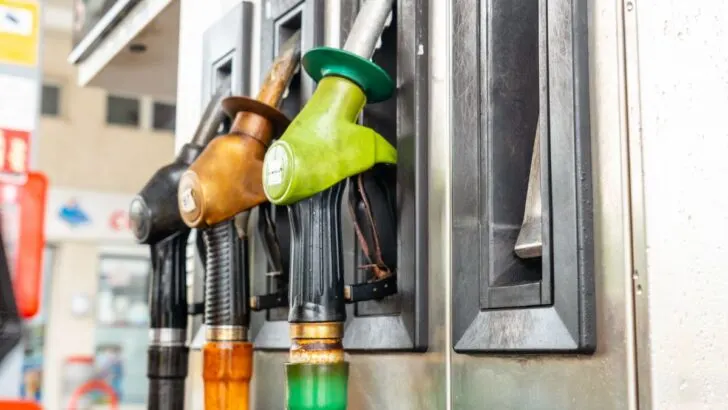Gasoline is a commonly used fuel for various everyday vehicles, generators, and machinery such as lawnmowers and chainsaws. It has long been associated with its familiar look when seen at gas stations and will typically exhibit a slightly yellowish, golden, or amber hue that can change from station to station.
But have you ever wondered about the actual true color of pure gasoline?
Pure gasoline is a clear, slightly yellowish liquid with a characteristic smell. As pure gasoline doesn’t have any color dyes, its slight yellow tinge comes from the petroleum-based hydrocarbons that it is made of.
This article aims to take a closer look at the interesting nature of gasoline’s color appearance and changes, exploring the reasons behind its range of hues and dispelling misconceptions surrounding its color.
Reasons for a Color Change
Various impurities or additives can potentially alter the appearance of gasoline and give it a different color.
Let’s take a look at some of the impurities that can affect the color of gasoline!
1. Oxidation
When gasoline is exposed to air for an extended period, it can start oxidation.
This process can cause the formation of varnishes or gums that can give the fuel a darker color, often appearing yellowish or light brownish.
2. Contaminants
Gasoline can come into contact with contaminants during storage, transportation, or handling.
Particles such as dirt, rust, or sediment can introduce impurities that may discolor the fuel, leading to a cloudy or orangish color appearance.
3. Additives
Gasoline may contain additives introduced during the refining process or as part of different fuel formulations depending on the needs of the gas.
These additives can have specific functions like improving octane rating, reducing engine deposits, or enhancing performance.
Some additives, particularly those with dye properties, can change the color of gasoline drastically to help with the identification or government regulation of this fuel.
4. Ethanol
Gasoline blends often contain ethanol which is a renewable fuel additive derived from corn or sugarcane.
The basic level of ethanol-blended gasoline, commonly known as E10, can have a slightly different appearance compared to pure gasoline with a light yellow coloration.
4. Degradation
Over time, gasoline can degrade due to factors like exposure to heat, moisture, or contaminants.
This degradation can lead to the formation of different mineral compounds that alter the fuel’s color resulting in a darker yellow or brownish appearance.

Colors of Ethanol Blends
The color variation in ethanol-blended gasoline is primarily influenced by the presence and concentration of ethanol in the fuel mixture.
Here are the main color characteristics associated with some different ethanol blends:
E10 (10% Ethanol)
E10 gasoline contains up to 10% ethanol and typically appears slightly cloudy compared to pure gasoline.
The presence of ethanol imparts a subtle yellowish tint to the fuel.
E15 (15% Ethanol)
E15 gasoline with 15% ethanol added may exhibit a slightly deeper yellow color compared to the previous E10.
The higher ethanol concentration intensifies the yellow hue but keeps it within a relatively light shade overall.
E85 (85% Ethanol)
E85 fuel consisting of 85% ethanol has a significantly different appearance compared to both pure gasoline and lower ethanol blends.
E85 can range in color from clear to light yellow, often with a very distinct yellow tone due to the high ethanol content.
It’s important to note that the color variations in ethanol blends are relatively subtle in most cases, and the exact appearance can vary depending on factors such as the specific gasoline formulation, the quality of ethanol that was blended, and any additional additives present in the fuel.
The color perception can also be influenced by the lighting conditions and the container through which the fuel is observed.
Does Color Determine Quality?
Color is not typically used as a direct quality indicator in most pure gasoline or ethanol blends.
Gasoline quality is normally assessed through standardized laboratory tests that evaluate various parameters such as octane rating, volatility, distillation characteristics, sulfur content, and other chemical properties.
These scientific tests provide a comprehensive assessment of what is expected as far as the fuel’s performance, efficiency, and environmental impact.
While color alone does not serve as a definitive indicator of gasoline quality, it can sometimes provide a small amount of information about the fuel’s condition, age, or potential issues that may arise from using it.
Here are a few scenarios where color may be associated with fuel quality and may be a reason for different concerns:
1. Discoloration due to Contaminants
If gasoline appears visibly discolored, such as having a cloudy or dark appearance, it could indicate the presence of contaminants like dirt, rust, or sediment.
These impurities may affect the fuel’s performance, clog filters, or contribute to engine deposits.
2. Oxidation and Degradation
Over months or years, gasoline can degrade due to exposure to heat, excess moisture, or long-term storage. This degradation can lead to the formation of varnishes, gums, or other compounds in the liquid that can darken the fuel’s color.
While color change alone does not necessarily imply poor quality, it may suggest that the fuel has been stored for an extended period or exposed to unfavorable storage conditions.
3. Presence of Dyes
In some cases, gasoline may be dyed for taxation or regulatory purposes.
The presence of bright or distinct colors such as red, green, or blue introduced through synthetic dyes does not normally indicate fuel quality in any way.
Instead, it serves as an identification and enforcement measure for specific fuel types or uses such as off-road, agricultural use, and more!
If you found this article helpful, make sure to take a look at some of the other fuel color-related posts below!
